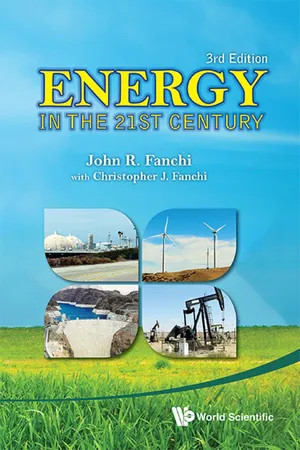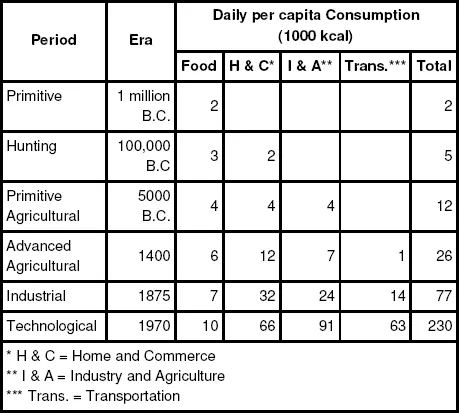![]()
CHAPTER 1
A BRIEF HISTORY OF
ENERGY CONSUMPTION
We all make decisions about energy. We decide how much electricity we will use to heat or cool our homes. We decide how far we will go every day and the mode of transportation we will use. Those of us in democracies choose leaders who create budgets that can support new energy initiatives or maintain a military capable of defending energy supply lines. Each of these decisions and many others impact the global consumption of energy and the demand for available natural resources. The purpose of this book is to give you the information you need to help you make informed decisions.
The choices we make today will affect generations to come. What kind of future do we want to prepare for them? What kind of future is possible? We can make the best decisions by being aware of our options and the consequences of our choices. In this book, we consider the location, quantity and accessibility of energy sources. We discuss ways to distribute available energy, and examine how our choices will affect the economy, society, and the environment. Our understanding of each of these issues will help us on our journey to energy independence. We begin by defining energy and reviewing our history of energy consumption.
1.1 WHAT IS ENERGY?
Energy is the ability to do work. It can be classified as stored (potential) energy, and working (kinetic) energy. Potential energy is the ability to produce motion, and kinetic energy is the energy of motion. Forms of energy include energy of motion (kinetic energy), heat (thermal energy), light (radiant energy), photosynthesis (biological energy), stored energy in a battery (chemical energy), stored energy in a capacitor (electrical energy), stored energy in a nucleus (nuclear energy), and stored energy in a gravitational field (gravitational energy).
Sources of energy with some common examples include biomass (firewood), fossil fuels (coal, oil, natural gas), flowing water (hydroelectric dams), nuclear materials (uranium), sunlight, and geothermal heat (geysers). Energy sources may be classified as renewable or nonrenewable. Nonrenewable energy is energy that is obtained from sources at a rate that exceeds the rate at which the sources are replenished. Examples of nonrenewable energy sources include fossil fuels and nuclear fission material such as uranium. Renewable energy is energy that is obtained from sources at a rate that is less than or equal to the rate at which the sources are replenished. Examples of renewable energy include solar energy and wind energy.
Renewable and nonrenewable energy sources are considered primary energy sources because they provide energy directly from raw fuels. A fuel is a material which contains one form of energy that can be transformed into another form of energy. Primary energy is energy that has not been obtained by anthropogenic conversion or transformation. The term “anthropogenic”refers to human activity or human influence. Primary energy is often converted to secondary energy for more convenient use in human systems. Hydrogen and electricity are considered secondary sources of energy, or “carriers”of energy. Secondary energy sources are produced from primary sources of energy and can be used to store and deliver energy in a useful form.
Modern civilization depends on the observation that energy can change from one form to another. If you hold this book motionless above a table and then release it, the book will fall onto the table. The book has potential energy when it is being held above the table. The potential energy is energy associated with the position of the book in a gravitational field. When you drop the book, the energy of position is transformed into energy of motion, or kinetic energy. When the book hits the table, some of the kinetic energy is transformed into sound (sonic energy), and the rest of the kinetic energy is transformed into energy of position (potential energy) when the book rests on the table top.
Energy transformation is needed to produce commercial energy. As an illustration, suppose we consider a coal-fired power plant. Coal stores energy as chemical energy. Combustion, or burning the coal, transforms chemical energy into heat energy. In steam power plants, the heat energy changes water into steam and increases the energy of motion, or kinetic energy, of the steam. Flowing steam spins a turbine in a generator. The mechanical energy of the spinning turbine is converted to electrical energy in the generator. In a real system, energy is lost so that the efficiency of electrical energy generation from the combustion of coal is less than 100%. A measure of the energy that is available for doing useful work is called exergy.
Real power systems transform energy into useful work, but some of the energy is wasted. The energy efficiency of a system is the amount of energy needed by the system to perform a specific function divided by the amount of energy that is supplied to the system. Energy efficiency has a value between 0% and 100%. Some of the energy supplied to a real system is lost as non-useful energy so that the energy efficiency is less than 100%. For example, suppose we have two light bulbs A and B. Both light bulbs provide the same amount of light, but light bulb B produces less heat than light bulb A and uses less energy than light bulb A. Consequently, light bulb B has higher energy efficiency than light bulb A because light bulb B uses less energy to achieve its intended purpose, to provide light.
In the light bulb example, we can reduce energy consumption by adopting a more energy efficient technology. Another way to reduce energy consumption is to turn off the light when it is not needed. In this case, we are conserving energy by changing our behavior. Energy conservation can be achieved by adopting a behavior that results in the use of less energy. An improvement in energy efficiency or conservation can be viewed as increasing the supply of useful energy because the improvement lets us get more value from existing energy sources.
Point to Ponder: What does an energy unit mean to me?
To get an idea of the meaning of an energy unit such as kilocalorie or megajoule, it is helpful to compare the energy consumed by the operation of modern devices. For example, a 1200 Watt hair dryer uses approximately one megajoule of energy in 15 minutes. A megajoule is 1 million Joules, which can be written as 106 Joules or 106 J. A 100 Watt light bulb uses approximately one megajoule of energy in about three hours. [Fanchi, 2004, Exercise 1-3]
If we run the 1200 Watt hair dryer for one hour, we will use
1.2 kilowatt-hours of energy. We abbreviate 1.2 kilowatt-hours as 1.2 kWh. A kilowatt (kW) is 1000 Watts. One kWh equals 1 kW times 1 hr, or about 3.6 x 106 J of energy. A typical American household will use between 20 and 50 kWh per day. Energy consumption in a household depends on such factors as how appliances are used, heating or cooling, etc.
A typical power plant provides approximately 1000 megawatts of power, which is abbreviated as 1000 MW of power. The power plant can provide power to approximately
900,0 households that use 10,000 kWh per year for each household.
A unit of energy that is commonly used for discussing energy on a national scale is the quad. One quad equals one quadrillion British Thermal Units (BTU) or 1015 BTU. A BTU is approximately 1000 Joules, so one quad is approximately 1018 Joules. A quad is comparable in magnitude to global energy values. For example, in 2010 the United States consumed about 100 quads of energy and the world consumed about 500 quads of energy.
Units and scientific notation are reviewed in Appendix A. Statistics that summarize energy production and consumption in the United States and the world are tabulated in Appendices B and C, respectively.
1.2 HISTORICAL ENERGY CONSUMPTION
The history of energy consumption shows how important energy is to the quality of life for each of us. Societies have depended on different types of energy in the past, and societies have been forced to change from one energy type to another. Global energy consumption can be put in perspective by considering the amount of energy consumed by individuals.
E. Cook [1971] provided estimates of daily human energy consumption at six different periods of societal development. The six periods from oldest to most recent are the Primitive Period, the Hunting Period, the Primitive Agricultural Period, the Advanced Agricultural Period, the Industrial Period, and the Technological Period. Cook’s estimates are given in Table 1-1 for each period. The table shows that personal energy consumption was relatively constant until the Advanced Agricultural period when it increased substantially.
Energy is essential for life, and food was the first source of energy. Cook assumed the only source of energy consumed by a person living during the period labeled “Primitive”was food. Cook’s energy estimate was for an East African about one million years ago. Humans require approximately 2000 kilocalories (about eight megajoules) of food per day. One food Calorie is equal to one kilocalorie, or 1000 calories. One calorie is the amount of energy required to raise the temperature of one gram of water one degree Centigrade. A change in temperature of one degree Centigrade is equal to a change in temperature of 1.8 degrees Fahrenheit.
The ability to control fire during the Hunting period let people use wood to heat and cook. Fire provided light at night and could illuminate caves. Firewood was the first source of energy for consumption in a residential setting. Cook’s estimate of the daily per capita energy consumption for Europeans about 100,000 years ago was 5,000 kilocalories (about 21 megajoules).
Table 1-1
Historical Energy Consumption [Cook, 1971]
The Primitive Agricultural period was characterized by the domestication of animals. Humans were able to use animals to help them grow crops and cultivate their fields. The ability to grow more food than you needed became the impetus for creating an agricultural industry. Cook’s estimate of the daily per capita energy consumption for people in the Fertile Crescent circa 5000 B.C. was 12,000 kilocalories (about 50 megajoules). Humans continue to use animals to perform work (Figure 1-1).
Figure 1-1. Animal Labor in Ahmedabad, India (Fanchi 2000)
More energy was consumed during the Advanced Agricultural period when people learned to use coal, and built machines to harvest the wind and water. By the early Renaissance, people were using wind to push sailing ships, water to drive mills, and wood and coal for generating heat. Transportation became a significant component of energy consumption by humans. Cook’s estimate of the daily per capita energy consumption for people in northwestern Europe circa 1400 was 26,000 kilocalories (about 109 megajoules).
The steam engine ushered in the Industrial period. It provided a means of transforming heat energy to mechanical energy. Wood wa...



